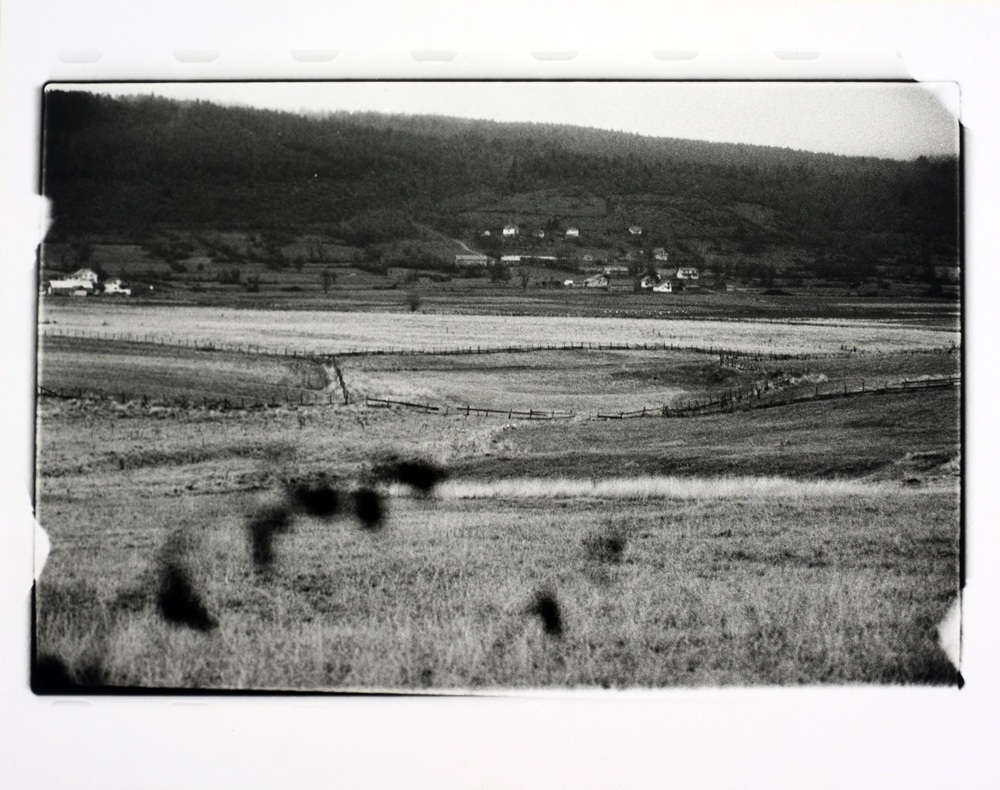Part I. Glasinac Plateau
Translation/Übersetzung: Norbert Sander
DOWN TO SARAJEVO, Part I. November 2014, rainy awakening somewhere on the Glasinac plateau northeast of Sarajevo. The clouds passed. With an air of suspicion, an old woman crossed the pasture. I had come across suspicion a few days before while I was chatting with a group of kids standing in front of a refugee camp in Salakovac/Mostar: A leery looking refugee camp worker (wearing a conservative lady suit and a brooch) gently patted the group of kids away from me back to the camp area. In 1995, two out of four million people living in Bosnia-Herzegovina were refugees (for the most part inland refugees, in other words, homeless “residents”). Over the preceding 20 years, the number of refugees has fallen quite substantially to 150.000 in 2015. While this is a remarkable reduction, the living conditions inside the camps continue to be bad. There are 17 officially recognized ethnic minority groups in Bosnia-Herzegovina, and I would presume that the refugees mainly come from these minorities. To make things worse: As much as a voluntary return to their respective native regions is encouraged and planed, such returns often provoke re-traumatization.
I had stopped here before, on a trip from Sarajevo to Srebrenica in 2008, and taken a short but dearly needed rest on the grass, only a few hundred meters away. Even back then, one question had bothered me: Is this place still untouched by war, or did happen here what – in the deep calm of the pasture – I am unable to picture?
HINUNTER NACH SARAJEVO, TEIL 1. November 2014, regnerisches Erwachen in der Glasinac-Hochebene nordöstlich von Sarajevo. Wolken ziehen vorüber. In der Ferne läuft eine alte Frau mit argwöhnischem Blick über die Weide. Misstrauen auch vor Tagen als ich vor einem Flüchtlingscamp in Salakovac/Mostar mit Kindern sprach, die von einer Mitarbeiterin – biederes Kostüm mit Brosche – von mir fort getätschelt wurden. 1995 waren noch zwei von vier Millionen Einwohnern Bosnien und Herzegowinas (BiH) Flüchtlinge (größtenteils Binnenflüchtlinge, d.h. obdachlos innerhalb des Landes), 2015 sind es rund 150 000. Eine beachtliche Reduzierung. Dennoch: Die Lebensumstände in den Flüchtlingslagern sind schlecht. Die offene Frage besteht inwieweit vor allem Angehörige der 17 anerkannten Minderheiten in BiH betroffen sind? Und ein weiteres Übel: Die angestrebte Rückkehr in die alten Häuser und Wohnungen lösen nach wie vor Retraumatisierungen bei den Betroffenen aus.
Im Jahre 2008 lag ich, in der Glasinac-Hochebene, ein paar hundert Meter weiter, im Gras. Müdigkeit stoppte mich auf der Fahrt zwischen Sarajevo und Srebrenica. Eine Frage bereits damals im Kopf: Vom Kriege verschont oder geschah, was in der Stille unvorstellbar? Wie ich erfuhr, ereigneten sich in den 1990ern keine Kämpfe in der nahen Kleinstadt Sokolac, dem Stützpunkt der Streitkräfte der Republika Srpska (VRS), jedoch in den umliegenden Siedlungen: verstörend aufgrund der blutig, ausgetragenen, zeitnahen, menschlichen Auseinandersetzungen, erschreckend bzgl. der strukturellen Gewalt in der Stille, die – kriegsbezogen – in der Nähe schlummerte.
